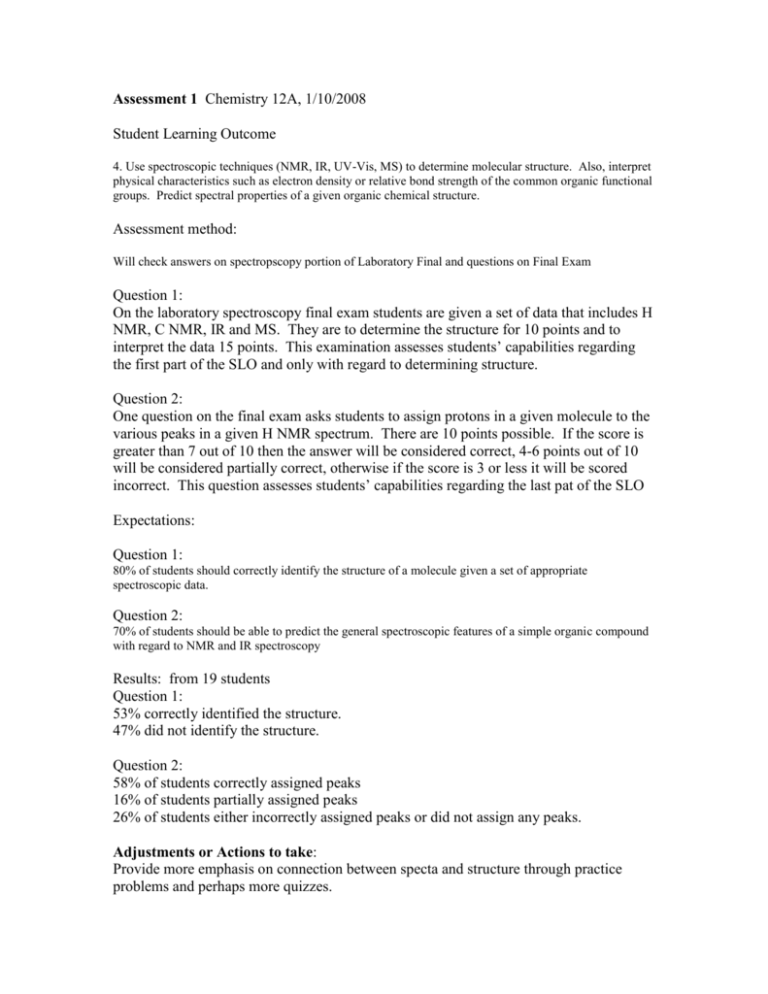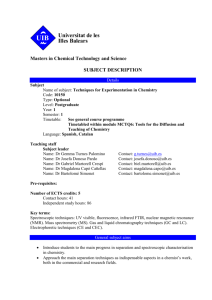Assessment of SLO
advertisement

Assessment 1 Chemistry 12A, 1/10/2008 Student Learning Outcome 4. Use spectroscopic techniques (NMR, IR, UV-Vis, MS) to determine molecular structure. Also, interpret physical characteristics such as electron density or relative bond strength of the common organic functional groups. Predict spectral properties of a given organic chemical structure. Assessment method: Will check answers on spectropscopy portion of Laboratory Final and questions on Final Exam Question 1: On the laboratory spectroscopy final exam students are given a set of data that includes H NMR, C NMR, IR and MS. They are to determine the structure for 10 points and to interpret the data 15 points. This examination assesses students’ capabilities regarding the first part of the SLO and only with regard to determining structure. Question 2: One question on the final exam asks students to assign protons in a given molecule to the various peaks in a given H NMR spectrum. There are 10 points possible. If the score is greater than 7 out of 10 then the answer will be considered correct, 4-6 points out of 10 will be considered partially correct, otherwise if the score is 3 or less it will be scored incorrect. This question assesses students’ capabilities regarding the last pat of the SLO Expectations: Question 1: 80% of students should correctly identify the structure of a molecule given a set of appropriate spectroscopic data. Question 2: 70% of students should be able to predict the general spectroscopic features of a simple organic compound with regard to NMR and IR spectroscopy Results: from 19 students Question 1: 53% correctly identified the structure. 47% did not identify the structure. Question 2: 58% of students correctly assigned peaks 16% of students partially assigned peaks 26% of students either incorrectly assigned peaks or did not assign any peaks. Adjustments or Actions to take: Provide more emphasis on connection between specta and structure through practice problems and perhaps more quizzes. Assessment 2 Chemistry 12A, 1/10/2008 Student Learning Outcome 7. Demonstrate how thermodynamic and kinetic principles can be used to characterize organic chemical reaction energy changes, mechanisms, and reaction rates. Assessment method: Check results of laboratory experiment focused on reaction rates and mechanisms to gauge understanding of connection between compound structure and mechanism. Results will be found on an open-notebook laboratory final question. Question 1 One question on the laboratory final asks students to indicate the method of analysis used during a mechanism-based discovery experiment and to make describe how their results indicated a given mechanism. Ten (10) points were given for the correlation of mechanism and results and at least 5 points indicated at a minimum a connection between their results and a mechanism. Expectations: 75% of students should correctly correlate mechanism with experimental data. 90% of students should indicate at least a connection between the experimental results of an experiment with a general mechanism. Results: from 19 students (out of 19 enrolled) 26% of students correlated the results with the mechanism 58% of students at least indicated a connection between the results and the mechanism 16% of the students had no idea either way. Adjustments or Actions to take: Provide more clarity and perhaps more examples of the connection between mechanism and the outcome of a given reaction mechanism. More clearly elucidate the connection in the laboratory setting. Assessment 3, Chemistry 12B, 1/10/2008 Student Learning Objective 4. Use spectroscopic techniques (NMR, IR, UV-Vis, MS) to determine molecular structure. Also, interpret physical characteristics such as electron density or relative bond strength of the common organic functional groups. Predict spectral properties of a given organic chemical structure. Assessment Method: Will check answers on standardized ACS for correctness of answers to structure determination questions. The 2004 ACS Organic Chemistry exam has 8 spectroscopy problems, four of which are solely interpretation of spectra to determine molecular structure. The remaining four questions ask the student to predict the product with the aid of provided spectra and therefore do not test students’ exclusive use of spectroscopic knowledge. There are three spectra from NMR (2) or IR (1) techniques, by themselves and one combeined NMR/IR question. Expectations: 70% of students should be able to predict the general spectroscopic features of a simple organic compound with regard to NMR and IR spectroscopy Results: 16 students took the ACS Exam 36% correctly answered the combined NMR/IR question 71% correctly answered the IR question 50% correctly answered the 1H NMR question 21% correctly answered the 13C NMR question Interestingly, one of the questions that combined identification of the product from a multi-step reaction with the aid of spectra was answered 93% correctly. Adjustments or Actions to take: Provide more emphasis on connection between specta and structure through practice problems and perhaps more quizzes.





